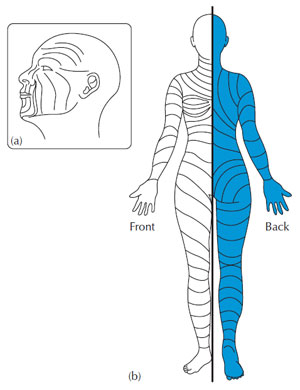Lying between the epidermis and the subcutaneous fat, the dermis is the support system for the epidermis, providing it with nutrients and oxygen and removing waste products. It consists largely of connective tissue.
Connective tissue consists of a ground substance with protein fibres distributed throughout it. The ground substance contains water and a mixture of large organic molecules which are a combination of polysaccharides (complex carbohydrates) and proteins. The most common type of polysaccharides in connective tissue is glycosaminoglycans (GAGS). These help to trap moisture, making the ground substance more jelly-like and viscous. GAGS include hyaluronic acid which binds cells together, lubricates joints and shapes the eyeball.
This ground substance plays an important role in providing bulk for the dermis which acts as a shock absorber and a lubricant between the collagen and elastin (protein) fibres when the skin moves. Due to its high viscosity, hormones, waste products and nutrients may pass through it; however, it is difficult for bacteria to move through.
|
Figure 2.5 Relaxed skin tension lines. On the
head and neck (a) these are readily identified by
following the existing wrinkle or skin-crease lines.
On the limbs the lines tend to run obliquely
around rather than along the limb (b). |
The protein component of the dermis is largely made up of collagen and elastin. Fibroblasts, which are found extensively throughout the dermis, are responsible for the production of collagen and elastin. The fibres that make up collagen are tough and resist stretching but they are flexible and as such they give structural strength to the skin. Bundles of collagen lie parallel to one another throughout the dermis forming cleavage or tension lines (Figure 2.5). Surgical incisions that are made parallel to these lines are much less likely to gape and will heal more effectively, than those that are made across tension lines. Collagen also has a strong water binding capability helping to maintain hydration in the dermis. Twenty-five percent of the body’s protein is collagen.
Elastic fibres, which are thinner than the collagenous fibres, are made of a stretchy, coiled protein called elastin. These springy fibres allow the skin to return to its normal shape after being stretched.
The dermis also contains tissue mast cells containing vasoactive chemicals (e.g. histamine); these are involved in moderating the immune and inflammatory responses in the skin and are found near hair follicles and blood vessels. Macrophages and histocytes are also present, which are phagocytic and engulf particulate matter. Blood vessels and cutaneous lymphatics run through the dermis, as do a number of nerve bundles and sensory receptors.
There are two distinct layers to the dermis, the papillary and the reticular.
At the interface with the epidermis, the papillary layer is approximately 1/5th of the total thickness of the dermis. It is the less dense of the two layers and contains thin elastic fibres. It also carries the blood vessels and nerve endings that supply the epidermis. This layer is thrown into ‘peg like’ projections known as dermal papillae which interlock with the rete pegs of the epidermis. Some of the dermal papillae contain capillary loops and others contain nerve endings and touch receptors such as Meissner’s corpuscles. The human fingerprint, unique to each of us, is created by dermal papillae lying on dermal ridges, thus producing epidermal ridges that create a print when in contact with a surface. Usefully, the epidermal ridges on palms and soles increase friction and allow for a better grip.
The denser reticular layer makes up the bulk of the dermis. It is packed with collagen and coarse elastic fibres that give the dermis its strength and flexibility.
